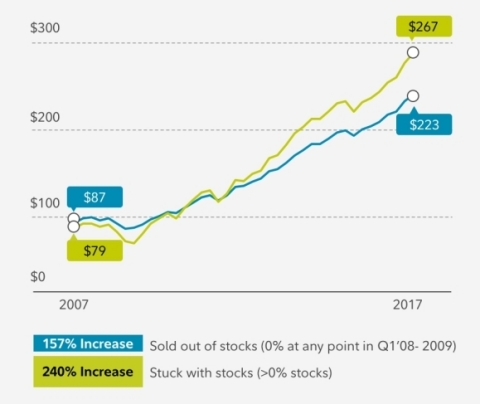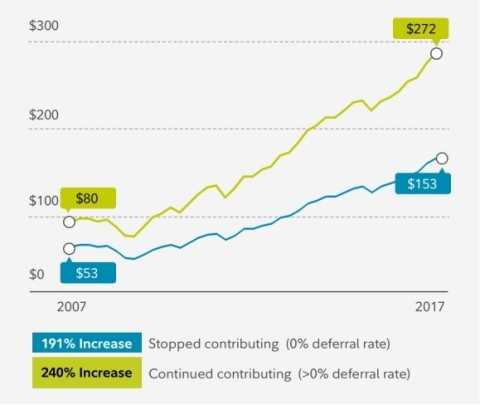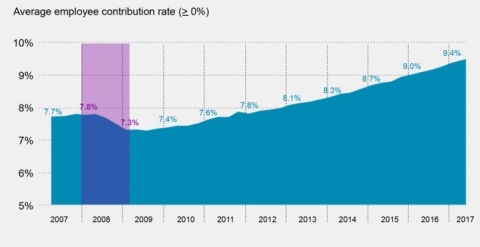BOSTON--(BUSINESS WIRE)--A lot has changed in the past decade, since the global financial crisis known as the Great Recession shook Americans’ lives and wallets. According to Fidelity Investments’® Ten Years Later analysis, consisting of an online survey of more than 1,200 Americans who began investing before the crisis as well as an analysis of Fidelity customer behavior1, while many people say their behavior has improved as a result of saving more, reducing debt and keeping a careful eye on long-term objectives, the actual evidence is mixed.
Fidelity’s online survey findings show only 38 percent of respondents feel more confident about their investment approach now than they did 10 years ago, a decrease from 48 percent when Fidelity conducted similar research five years ago2. In addition, today’s investors said the biggest changes made in the wake of the crisis were reducing debt and increasing savings; roughly 25 percent said the crisis caused them to reassess how much risk they could handle and shifted to a more conservative investment strategy.
However, there are indications the market’s recovery may be making it easier for people to forget these lessons. Looking strictly at customer behavior, Fidelity retirement plan savers who stuck with investing throughout the downturn have been rewarded in the long run. In fact, compared to those who fled the market and went to cash during the downturn, investors who held steady saw balances grow about 50 percent more3.
“Although there are many reasons why people chose to exit the market, looking back a decade later, investors who managed to stay the course have enjoyed better results,” said Ken Hevert, senior vice president of Retirement at Fidelity Investments. “What we’ve seen in the ensuing years is proof that the most prudent investors are those who resist being reactive and instead keep their financial objectives firmly in mind by looking beyond market volatility. No one knows when the next market downturn will take place, but those who learned from the last great financial crisis are more likely to be better positioned to weather future financial storms.”
In October 2007, housing sales had begun to decline, the Fed cut rates one-half point in the first of four rate cuts it would make that year, banks had decreased lending to one another, and the S&P 500® hit a high it would not revisit until 2014. In fact, from late 2007 through early 2009, the S&P lost about 40 percent of its value. All of this understandably caused many investors to worry whether markets could recover. Not so, as over the past ten years, much of this has been reversed and stocks have steadily climbed— from June 2007 to today, the S&P is now up 97 percent4. Based on the analysis, here are some lessons many investors took out of the greatest financial crisis in American history since the Great Depression:
Lesson No. 1: Keep Your Eye on the Long-Term—and Don’t Lose Your Cool
What
looks like a huge loss in the short-term can become blips as years pass,
demonstrating the importance of patience when saving for long-term
goals. This appears to be a learning many embraced, according to
Fidelity 401(k) data, and as a result, for the majority of investors who
were able to stick with a plan and continued to steadily contribute to a
401(k), account balances are now far higher than they were going into
the crisis. Consider the average Baby Boomer (born 1946-1964) in a
Fidelity workplace savings plan in 20075, who was still in
their plan in 2017:
- The average 401(k) account balance for Baby Boomers was $115,000 in June 2007.
- The downturn reduced that average account balance to $85,000 at the start of 2009.
- As of June 2017, the average account balance for Boomers who made continuous contributions the past 10 years climbed to $315,000—a near tripling of wealth in 10 years.
IRA savings tell a similar story: at the end of the year 2007, the average balance for Boomers was $30,368. Strictly looking at those who have maintained their IRA and regularly contributed, the average balance as of year-end 2016 was $96,3536.
In contrast, examining the small percentage of 401(k) savers who moved to cash during 2008 or the first quarter of 2009, or stopped contributing to their retirement plans completely, tells an entirely different story. For many, it has taken years to return to their pre-crisis savings rate or asset mix—five years after the crisis, a quarter of those who sold out of stocks still hadn’t reinvested them. Additionally, by the time others who exited started saving and investing again, the effect of lost savings and growth opportunities had already taken its toll7:
Lesson No. 2: Save More and Reduce Debt
Fidelity’s 10
Years Later online survey data identified additional positive
behaviors investors have adopted during the past decade. When asked
specifically what actions they have taken as a result of the financial
crisis, the No. 1 response was “reduce my debt” (36 percent), with
“increase my savings rate” coming in second at 26 percent. This
encouraging news is also seen in Fidelity investor data, which shows
that savings rates for 401(k) customers have trended upwards in the
ensuing decade, growing from a 7.7 percent deferral rate in the second
quarter of 2007 to a deferral rate of 9.5 percent in the second quarter
of 20178.
Still, there are reasons to be concerned that people may have started to forget this lesson. Part of the improvement is likely due to a combination of individual decisions and account features that automatically sets and raises savings rates over time. Additionally, while national debt levels decreased and savings rates increased shortly after the crisis, that trend has since reversed. The personal savings rate, after climbing from 2007 to 2012, has since fallen to 3.6 percent. Meanwhile, household debt levels hit an all-time high in June 2017, surpassing the record set in 20079.
Lesson No. 3: Manage risk with a mix of investments
Using a
mix of stocks, bonds, and cash to help manage the total volatility of a
portfolio has long been a core tenet of investing, and since the
financial crisis, it has become even more popular. According to the
online survey, 33 percent reported that as a result of the crisis, they
have changed their investment mix to become either more conservative or
more aggressive.
This is consistent with trends data on Fidelity’s 401(k) platform10. Today, only 11 percent of those workplace savers who have been in their plans since before the crisis are 100 percent in stocks or 100 percent in bonds, versus 26 percent in 2007. Furthermore, over the last decade, many plans have begun defaulting employees into target date funds and managed accounts, where professional portfolio managers set and maintain an investment mix. As a result, nearly half of workplace savers overall, including those who joined their plans during the crisis, are now invested in target date funds, including almost 70 percent of millennials.
This improvement has not been universal, however. Looking at trends data involving Fidelity IRA customers11, one in three accounts are still invested 100 percent in stocks or bonds. And, when one examines the equity allocation in IRAs—that mix between equity and fixed income investments—the data suggests this mix returned back to pre-crisis levels in 2015.
Lesson No. 4: When in Doubt, Consult a Professional
One
additional change appears to have occurred: more people are seeking out
professional help to build and manage their financial strategy. The
online survey shows one quarter of investors sought out the services of
a financial advisor as a result of the crisis. Interestingly, those who
did secure help from an advisor report they seem to be faring better
financially and are more confident than those that did not.
| Those who secured an advisor | Those who didn’t | |||||||
| Greater confidence | 50% feel more confident about current approach than they did 10 years ago | 31% feel more confident about current approach than 10 years ago | ||||||
| More debt-free | 41 percent have reduced their debt | 33 percent have reduced their debt | ||||||
| Saving more | 31 percent have increased savings rate | 23 percent have increased savings rate | ||||||
“What we’ve observed is that during times of market volatility, investors who aren’t panicking are those who already have a plan in place, either one they created on their own or through the help of an advisor,” said Hevert. “One advantage to having an advisor is they can help make sure you are on track to meet your long-term goals during market highs and lows. For example, the market is currently enjoying an all-time high, causing some to worry they may be overexposed to equities. An advisor can help you better ensure your portfolio is diversified and properly allocated to meet your needs, based on your time horizon and risk tolerance—and help you determine when and if it’s time to readjust.”
Resources for Investors to Get on the Right Track… and Stay There
Fidelity
Investments provides investors of all ages with the financial
intelligence they need to make informed decisions about their unique
situations. To learn more about the lessons from the financial crisis,
visit Fidelity
Viewpoints. To learn more about what’s going on in the market
and how to be prepared, investors can visit www.fidelity.com/viewpoints/uncertain-times,
which contains “Three
keys: the foundations of investing” and “Strategies
for uncertain times” for financial guidance on their specific
investment needs. Investors can also use Fidelity’s Planning
& Guidance Center, either online or with the help of a Fidelity
advisor, to assess their retirement readiness and ensure they are
prepared for any unexpected market changes. Within the Center, customers
can create or view their retirement plan, identify specific steps to
improve their readiness, model outcomes and review investment strategies
and make adjustments to their plan, when needed, to help ensure they
stay on track to achieve their goals.
About the Analysis
The Fidelity Investments 10 Years Later
analysis consists of two components: first, an online survey was
conducted among 1,205 adult current investors who were also investing 10
years ago. The survey was fielded August 24-30, 2017 by ORC
International, an independent research firm not affiliated with Fidelity
Investments. In addition, Fidelity analyzed the behavior of nearly 1.5
million participants in Fidelity workplace retirement plans and more
than 5 million clients with Individual Retirement Accounts (IRAs).
About Fidelity Investments
Fidelity’s mission is to inspire
better futures and deliver better outcomes for the customers and
businesses we serve. With assets under administration of $6.5 trillion,
including managed assets of $2.4 trillion as of September 30, 2017, we
focus on meeting the unique needs of a diverse set of customers: helping
more than 26 million people invest their own life savings, 23,000
businesses manage employee benefit programs, as well as providing more
than 12,500 financial advisory firms with investment and technology
solutions to invest their own clients’ money. Privately held for 70
years, Fidelity employs more than 40,000 associates who are focused on
the long-term success of our customers. For more information about
Fidelity Investments, visit www.fidelity.com/about.
1 This analysis is based on two components: First, an online
survey conducted among 1,205 adult current investors who were also
investing 10 years ago. That online survey was fielded August 24-30,
2017 by ORC International, an independent research firm not affiliated
with Fidelity Investments. In addition, to get a sense as to how
Fidelity customers fared, Fidelity analyzed the behavior of nearly 1.5
million participants in Fidelity workplace retirement plans and more
than 5 million clients with Individual Retirement Accounts (IRAs) from
June 2007 through June 2017.
2 SOURCE: The Fidelity
“Five Years Later” study was conducted online among 1,154 adult
investors by GfK Public Affairs and Corporate Communication using GfK’s
KnowledgePanel® during the period of February 12-25, 2013.
3,
5, 8, 10 Part of the Fidelity customer data, this data is based on
a longitudinal study of active participants in Fidelity record-kept
corporate defined contribution savings plans. The data looked at a
cohort of 1,470,700 participants who were active in workplace savings
plans for the entire period from June 2007 through June 2017. Please
note that past performance is not a guarantee of future results and
averages can obscure significant variation for individual account
results.
4 SOURCE: FactSet. Returns based on the S&P 500
Total Return Index.
6, 11 Part of the Fidelity customer
data, this data is based on a longitudinal study of active participants
in Fidelity IRA accounts. The data looked at a cohort of more than 5
million clients with Individual Retirement Accounts (IRAs) for the
entire period from year-end 2007 through year-end 2016. Please note that
past performance is not a guarantee of future results and the averages
can obscure significant variation for individual account results.
7
Chart is for illustration only. Data shows the average account balance
for continuous participants in Fidelity workplace savings plans for the
10 years from June 2007 through June 2017. "Sold out of stocks"
indicates a saver who had equities but moved to 0% equities during 2008
or the first quarter of 2009. "Stopped contributing" indicates a saver
who reduced their contribution rate to 0% in 2008 or the first quarter
of 2009. Past performance is not a guarantee of future results. See
footnote 3 for additional details. Source: Fidelity.
9
SOURCE: National
household debt, Federal Reserve Bank of New York, Personal
Savings Rate, Federal Reserve Bank of St. Louis.
IMPORTANT: The projections or other information generated by the Planning & Guidance Center's Retirement Analysis regarding the likelihood of various investment outcomes are hypothetical in nature, do not reflect actual investment results, and are not guarantees of future results. Your results may vary with each use and over time.
Past performance is no guarantee of future results.
Investing involves risk including the risk of loss.
Fidelity
Investments and Fidelity are registered service marks of FMR LLC.
Fidelity Brokerage Services LLC, Member NYSE, SIPC
900
Salem Street, Smithfield, RI 02917
Fidelity Investments Institutional Services Company, Inc.
500
Salem Street, Smithfield, RI 02917
National Financial Services LLC, Member NYSE, SIPC
200
Seaport Boulevard, Boston, MA 02110
821433.1.0
© 2017 FMR LLC. All rights reserved.






